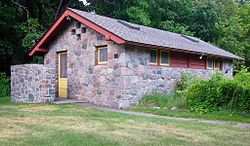Buffalo River State Park (Minnesota)
| Buffalo River State Park | |
| Minnesota State Park | |
|
Native prairie in Buffalo River State Park
|
|
| Named for: the Buffalo River | |
| Country | United States |
|---|---|
| State | Minnesota |
| County | Clay |
| Location | Glyndon |
| - elevation | 981 ft (299 m) |
| - coordinates | 46°51′53″N 96°27′36″W / 46.86472°N 96.46000°WCoordinates: 46°51′53″N 96°27′36″W / 46.86472°N 96.46000°W |
| Area | 1,068 acres (432 ha) |
| Biome | Northern tall grasslands |
| Founded | 1937 |
| Management | Minnesota Department of Natural Resources |
|
Buffalo River State Park WPA/Rustic Style Historic Resources
|
|

One of the district's six contributing properties, a 1938 latrine
|
|
| Location | Off US 10, Riverton Township |
|---|---|
| Area | 19 acres (7.7 ha) |
| Built | 1937–1940 |
| Architect | O. Newstrom |
| Architectural style | National Park Service rustic |
| MPS | Minnesota State Park CCC/WPA/Rustic Style MPS |
| NRHP Reference # | 89001671 |
| Added to NRHP | October 25, 1989 |
Buffalo River State Park is a state park of Minnesota, United States, conserving a prairie bisected by the wooded banks of the Buffalo River. Together with the adjacent Bluestem Prairie Scientific and Natural Area owned by The Nature Conservancy, it protects one of the largest and highest-quality prairie remnants in Minnesota. With the closest swimming lake to the Fargo–Moorhead metropolitan area, however, it is most popular for swimming and picnicking. The 1,068-acre (432 ha) park is located just off U.S. Route 10 in Clay County, 4.5 miles (7.2 km) east of Glyndon and 14 miles (23 km) east of Moorhead.
Buffalo River State Park was established in 1937 and developed by the Works Progress Administration. Three buildings and three structures built in the National Park Service rustic style were added to the National Register of Historic Places in 1989. The park was originally focused on providing outdoor recreation amenities like the swimming pool, since there were few other opportunities in the area. It was expanded beginning in the 1960s as the quality and rarity of the surrounding prairie were recognized.
The 6,078-acre (2,460 ha) Scientific and Natural Area (SNA) section is used for environmental education by local schools and regional colleges and universities. It is also a destination for viewing the spring courtship ritual of the greater prairie chicken.
The topography of Buffalo River/Bluestem Prairie largely formed beneath a proglacial lake at the end of the last glacial period. The region had previously been covered and exposed many times by successive glaciations. As the ice of the Wisconsin glaciation melted, the Red River Valley was covered by Glacial Lake Agassiz 10,000–8,000 years ago. Fine sediments formed a level lakebed. However beach ridges of sand and gravel formed in various places as the shorelines shifted. There is a beach ridge on the east edge of the state park called Campbell Ridge, and another to the southeast in the SNA called Norcross Ridge. The bedrock—a thin layer of shale over granite, slate, and schist—lies beneath 250–500 feet (76–152 m) of silt deposited by Lake Agassiz. The lake finally drained away to the north, leaving behind a distinctly flat plain with very rich soil.
...
Wikipedia


